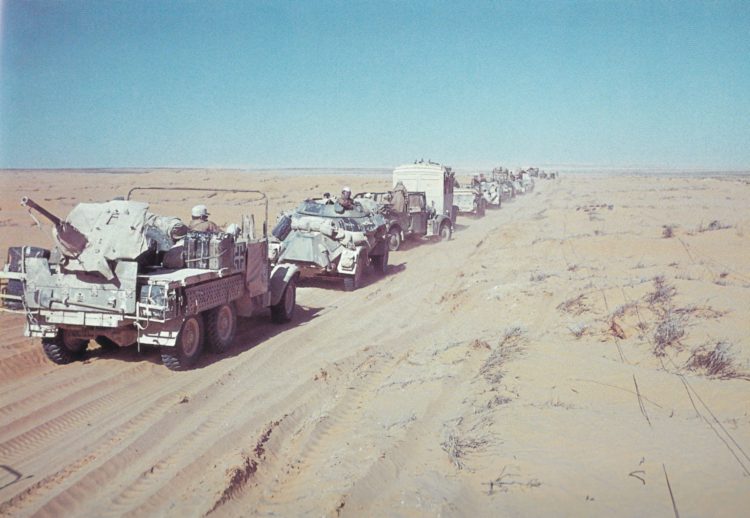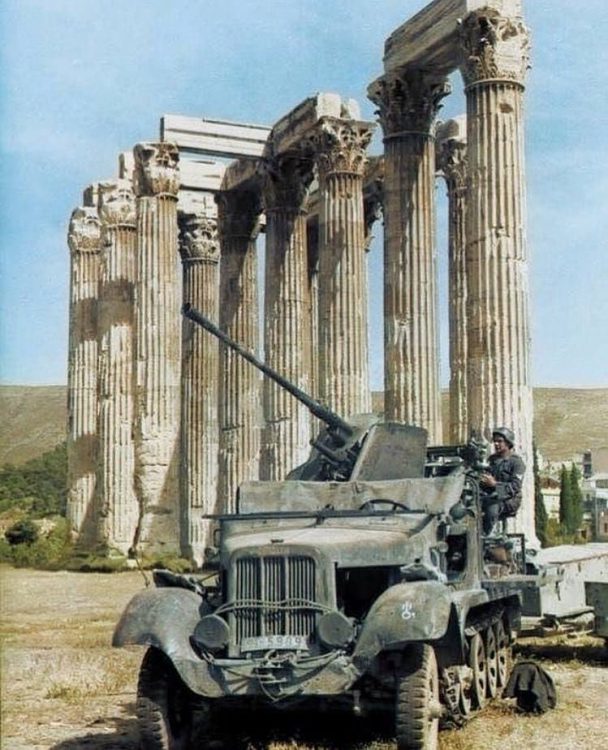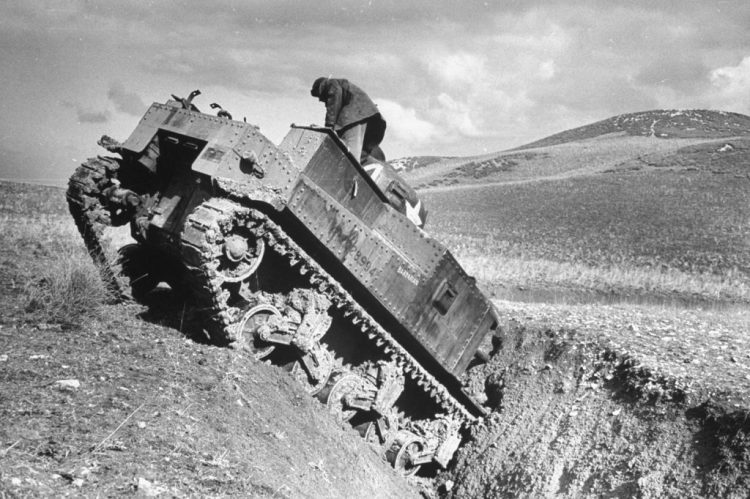Goonhammer Historicals is our series looking at the incredibly diverse world of historical wargaming – different scales, different eras, different rulesets. Today in Goonhammer Historicals Marc “Ilor” Renouf takes a look at getting started with World War 2 gaming in North Africa, from the commencement of hostilities in East Africa to the culmination of the events of Operation Torch.
For over a century prior to the beginning of World War 2, the various European powers had engaged in the mad “Scramble for Africa” in which they established colonies throughout the continent. As such, when hostilities started between the Axis and Allied forces, it was a foregone conclusion that the conflict in Europe would spread to the African continent. Indeed, between the Axis conquest of France in mid 1940 and the Allied invasion of Sicily in mid 1943, it was actually in Africa that the bulk of the fighting between the western European powers took place.
Historical highlights
The fighting in Africa changed radically over the course of the war, usually as a result of new forces being drawn into the fray or new equipment being fielded by the various combatants. Generally speaking, the conflict breaks down into three smaller theaters.
East Africa (Abyssinia)
An often overlooked theater of the war, the first conflicts in Africa took place predominantly in what is now Somalia, Sudan, Ethiopia, Eritrea, and Kenya between the British and the Italians. Both had colonial interests in the region, and the initial stages of the conflict saw invasions by Italian forces across multiple fronts. Early in the campaign the Italians held a significant numerical superiority, and early battles saw British forces fighting a series of desperate delaying actions and withdrawals. But in a pattern that would be repeated elsewhere in Africa throughout WW2, the Allied edge in logistics (and in particular their control of the Suez Canal) would eventually lead to the British reversing the Italians’ early gains.
The fighting in East Africa took place in incredibly varied terrain, from rocky deserts to fertile floodplains to grassy uplands, making it easy to put together a decent wargaming table with whatever terrain you have handy. It is also very much an “early war” theater, so if you love troops on horseback, goofy tankettes, and hilarious armored cars, this is the conflict for you.

The Western Desert
When most people think of fighting in North Africa, they envision massive forces of tanks sweeping back and forth across the open desert, and this is exactly the kind of warfare that took place in the eastern reaches of the Sahara (ironically referred to as the “western” desert because it’s the western portion of Egypt). This campaign saw a series of rapid advances in turn by both the Axis and Allied forces, followed by swift reverses as they raced ahead of their logistical tails and literally ran out of gas. This theater also saw the German entry into North Africa, with the Deutsches Afrika Korps coming to the aid of the Italians in March of 1941. The fighting in the western desert took place in some of the harshest, most forbidding terrain on earth, and the toll on men and vehicles alike was intense. Numerous battles took place here, from the bold Operation Compass that nearly ejected the Italians from North Africa to the swirling, massively complicated Operation Crusader’s attempt to relieve the siege of Tobruk, to the action that Churchill famously dubbed the “end of the beginning” – the second battle of El Alamein.
This era of the fighting in North Africa was characterized by armored clashes in the open desert and hard-fought infantry actions along a series of ridges and escarpments, each strategically important for the field of view they offered commanding the surrounding terrain.

Operation Torch
Following the Axis defeat at El Alamein and their retreat from Tripolitania (modern-day Libya), the sole remaining Axis bastion in North Africa was Tunisia. Operation Torch was the name given to the Allied offensive that sought to wrest control of Tunisia from the Axis forces once and for all. It saw the entry of American forces into the war, and served as the model for allied cooperation between American, British, and French forces in later theaters. This campaign involved amphibious landings, the surprise Axis counterattack at Kasserine Pass, the British 8th Army’s punch through the Mareth Line, and the race between allied forces to see which would be the first to capture Tunis itself (a prelude to the race for Berlin two years later).
Operation Torch marks the beginning of what many World War 2 wargamers characterize as the “mid-war” period, and as such includes a dizzying diversity of tanks and equipment on both sides. This stage of the conflict is also interesting because of the wide variety of troops that took part; if you’ve always wanted an excuse to field French Senegalese Tirailleurs, this campaign is right up your alley.

What games should I play?
There is a huge number of historical game systems covering World War 2, too many to cover in but the broadest strokes in this article. But here we present a few that are well-suited to the conflict in North Africa in particular.
Chain of Command by Too Fat Lardies
TFL’s Chain of Command really sets the bar when it comes to platoon-scale WW2 games, and is something of a cult favorite here at Goonhammer. Edwin “Lupe” Moriarty did a nice review of it in an earlier article, but suffice it to say it’s really good. Specifically, the game has a novel activation mechanic that captures the barely-contained chaos of the WW2 battlefield extremely well. Additionally, the game supports and rewards historically accurate tactics, and the forces are based on actual historical unit formations with a balancing mechanic on top that does a nice job of leveling the playing field.
Though it’s not included in the base game, I highly recommend the “At the Sharp End” supplement which includes extended rules for running campaigns of linked battles. While Chain of Command is really good as a stand-alone game, it is fantastic in campaign play – where suddenly casualties matter in the long term and you have to balance your desire to accomplish your objectives quickly with your desire to not have your men frag you for callously throwing their lives away. The PDF version is only £8, and it’s well worth it.
You can grab the rules for Chain of Command from the Too Fat Lardies’ website.
Bolt Action by Warlord Games
Bolt Action is probably the most popular WW2 rule set, which will increase your chances of finding a game at your local game store. It is characterized by an alternating unit activation mechanic, where each force puts a die in the bag for each of its constituent units. When a die of your color is drawn, you choose which of your units to activate. This breaks the standard “IGOUGO” turn-order in fun and interesting ways. Force composition is based on a point-scale like most popular sci-fi miniatures games, and while this is intended to ensure balance between opposing players it can often produce forces that are wildly ahistoric. While Bolt Action is oriented around tournament-style play, there are published campaign books for various stages of the war – including the campaign for North Africa.
You can find all of the Bolt Action range here
Flames of War by Battlefront
Now in its 4th edition, Flames of War is a 15mm wargame. Unlike Chain of Command or Bolt Action (both of which generally focus on forces of about a platoon in size), Flames of War is designed to model larger engagements at the company or even battalion scale. If you want to push around loads of tiny tanks and have artillery represented on the tabletop, Flames of War might just be your game. The game uses a different approach to army lists, with different lists being categorized by Early, Mid, and Late war (the North Africa lists are predominantly mid-war). The launch of 4th Edition focused on North Africa, so the period is well supported. Flames of War suffers from some of the problems that plague Bolt Action (namely that the system is more concerned with tournament style play than historical representation), but the support for the game is impressive in terms of miniatures and source material.
Head to Battlefront Games’ webstore for more info on Flames of War
Wings of Glory by Ares Games and Bag the Hun by Too Fat Lardies
If World War 1 saw the introduction of aerial combat, World War 2 saw those principles honed to deadly perfection. While most WW2 games focus on land warfare, we’d be remiss if we didn’t at least mention a couple of rules systems designed to model this important aspect of the conflict – especially given how critical the air-war over the Mediterranean was to the logistics of forces fighting in North Africa.
In this category there are two offerings that spring immediately to mind, those being “Wings of Glory” by Ares Games and “Bag the Hun” by Too Fat Lardies. Both games model the basics of air-to-air combat very well. Wings of Glory uses mechanics that are reminiscent of sci-fi dogfight games like X-Wing and will feel very familiar to veterans of that game (the chief one being that both sides plot their next moves “blind” using cards). Bag the Hun uses a random, card-based activation mechanic that will be intuitive to anyone familiar with other Lardie games. The one advantage that I’d give to Bag The Hun is that the rules for other types of sorties – bombing raids, strafing runs, anti-ship operations, etc – are supported in the base game. Its one drawback is that Bag the Hun is designed to be played on a hex-map.
You can get Wings of Glory directly from Ares Games website and Bag the Hun from Too Fat Lardies’ online store.
What miniatures should I buy?
Perry Miniatures

Though the Perry brothers’ WW2 offerings are relatively limited, the good news is that they’ve chosen to concentrate on North Africa. The even better news is that they offer a “platoon in a box” for both DAK and the British 8th Army, and recently released American GIs. It’s worth noting that the Perry sculpts tend to be realistic in their proportions, and will look a little skinny compared to the offerings of other manufacturers. But for sheer value, the Perry boxes are hard to beat – you can field two complete opposing forces for as little as £40 combined (roughly $50). This was how I got my start in WW2 gaming, and I’d highly recommend it to anyone else who wants to try out the period without sinking in a lot of cash up-front.
You can snag these beautiful minis from the Perry website
Warlord Games
For years, Warlord Games carried the aforementioned Perry DAK and 8th Army boxes, but in 2019 they released their own plastic ranges to cover these iconic forces. These new sculpts are of the same “heroic” proportions as most of Warlord’s other offerings, and perfectly complement their already massive offerings of support troops – machine gun, mortar, and artillery guns and crews, force commanders, etc. Warlord also carries an extensive range of Italian sculpts, both in standard and desert uniforms. Further, all of their Italian troops use their “Figure Head” system (where each figure comes with multiple head options), which makes it easy to swap out standard helmets or pith helmets, with or without Bersaglieri ostrich plumes.
But by far the area where Warlord shines brightest for North Africa games lies in their vehicle offerings. While their range of resin vehicles is truly staggering, the plastic kits they co-produce with noted model-maker Italeri in particular are quite good, being simultaneously detailed, easy to assemble, and usually giving you options for different variants (that I always end up compulsively magnetizing to field in multiple configurations).

If you’re playing an aerial combat game, the 1/200th scale planes available for Warlord’s Blood Red Skies range are very nice, and Blood Red Skies itself is worth checking out.
Battlefront

In support of their popular Flames of War game, Battlefront offers several different infantry units for each of the major combatants and a huge variety of vehicles, all in 15mm. Even if you’re playing a game like Chain of Command, going to 15mm is another great way to save some money. The infantry figures have a surprising amount of detail, but tend to suffer from having the “enormous hands and potato faces” aesthetic that puts some people off. The vehicles however are very well designed and sculpted.
You can buy Battlefront’s miniatures from their online store
Old Glory Miniatures
This is a little bit of a throwback, as Old Glory is one of those manufacturers that’s been around forever. They only offer WW2 figures in their 15mm range, but the sculpts they have are really nice. They’re generally well-proportioned and have some really characterful poses. Just be aware that they only do infantry figures, so if you’re looking for vehicles you won’t be able to take advantage of one-stop shopping.
You can buy 15mm miniatures from Old Glory’s website



